November 2025 Release Notes
November 27, 2025
IMPROVED ORCHESTRATION ENGINE Better integration with Action Flows
We’re not stopping with updates to Orchestration Engine. Our newest set of changes brings tighter integration between Process Orchestration and Action Flows:
Faster Action Flows creation: Each new Action Flow created from Process Orchestration comes with predefined settings to make it immediately available for use without any additional configuration required. These settings include on-demand scheduling, dpInstanceId input, and the Completion Event module.
Instant reusability: Process Orchestrations can now be instantly used by Action Flows in the same Studio package. You don't have to create and configure a dedicated OAuth application anymore.
Direct Action Flow management: Access, monitor, and activate Action Flows directly in Process Orchestration when adding a new process step.
See Adding Action Flows to Process Orchestration.
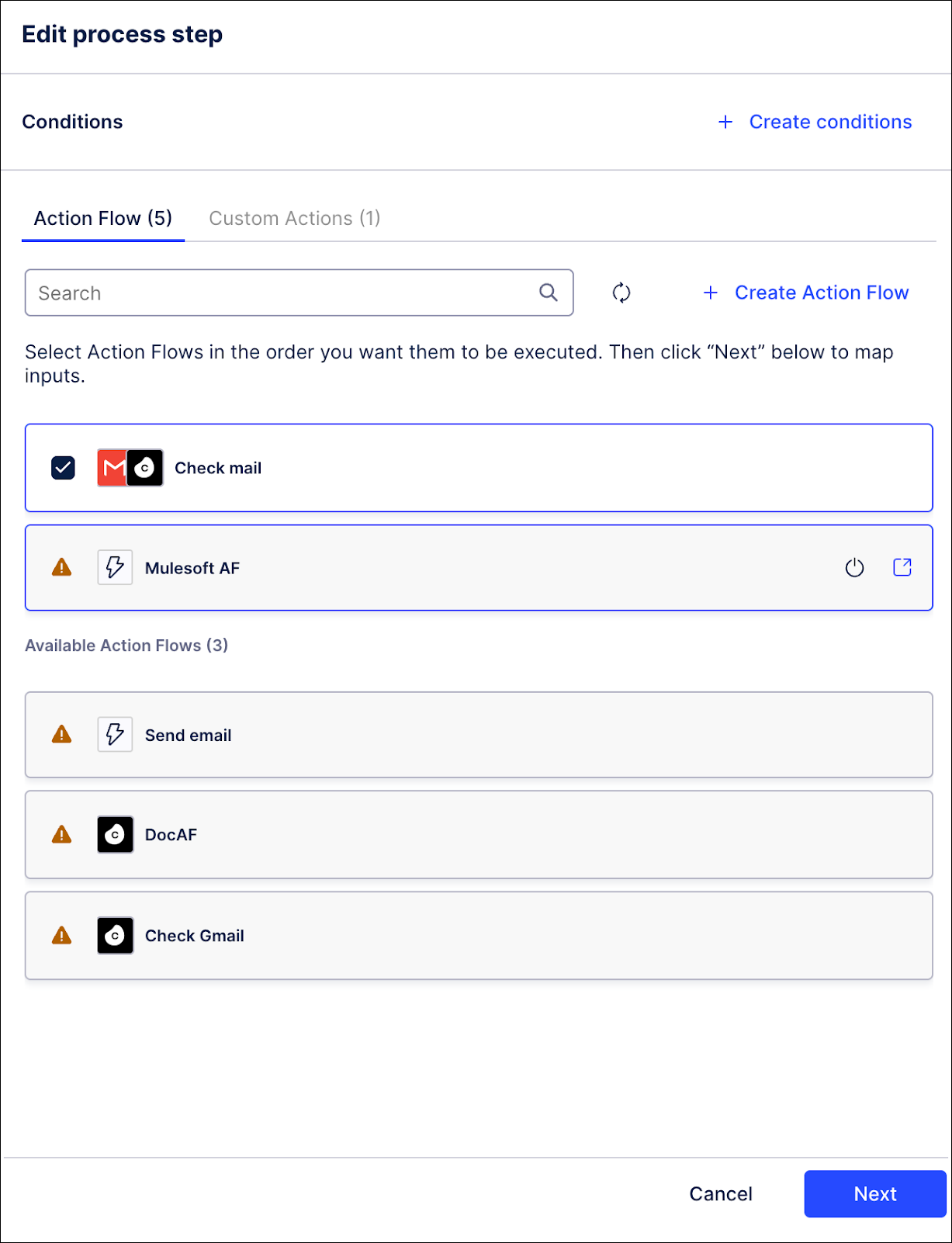
November 21, 2025
NEW MACHINE LEARNING Use the PyCelonis library to interact with Studio assets
The latest update to the PyCelonis library introduces the ability to programmatically interact with Studio Views. While the management of Spaces, Packages, and Knowledge Models was already supported, this release fills a critical gap, allowing you to create, configure, and inspect Views using Python scripts.
This update enables deeper automation of your Studio workflows. Beyond just organizing the structure of your application (Spaces and Packages), you can now use methods like package.create_view() to generate user interfaces programmatically. Furthermore, you can access the content of published views—down to specific tabs and components—to extract PQL queries or validate configurations.
These new features unlock end-to-end Continuous Integration / Continuous Deployment (CI/CD) capabilities, allowing you to script the creation of the visual layer of your Celonis apps alongside the logic. To start building Views programmatically, ensure you have the latest version of PyCelonis installed. For more information, see PyCelonis.
NEW MACHINE LEARNING Pycelonis Large Language Model in workbenches now in GA
Users of the Machine Learning Workbench now have a new option to integrate existing Celonis Large Language Models (LLMs) directly into their workbenches. The new pycelonis_llm offers users a client library to integrate any Celonis LLM to their workbench and includes automatic patching for common Python frameworks such as OpenAI, LiteLLM, LangChain, and LlamaIndex to make them compatible with the integrated LLM. This allows users to leverage the same LLMs they already use in Celonis tools like Process Copilot and Annotation Builder directly within their ML Workbench code.
Note
As an additional part of this release, asynchronous support is now available when working with LLMs in the Celonis Platform.
This new integration improves the experience of building custom AI-powered applications using Python tools and removes the need for separate API keys or integrations. Users can simply import pycelonis_llm and use the library to automatically handle the connection to the LLM and authentication.
Note
Your workbench must be configured to allow LLMs in order to install this integration. To allow LLMs in your workbench, the “Enable LLMs” check box must be selected on the Create Workbench or Edit Workbench screen.
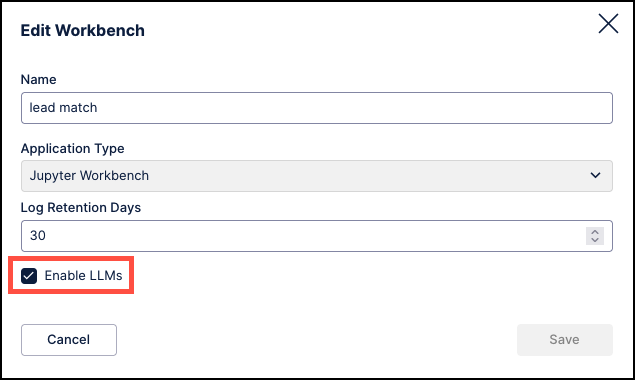 |
To install the required Python package in your workbench environment, run %pip install pycelonis-llm. Note that the pycelonis-llm library is only compatible with machine learning workbenches in the Celonis Platform and cannot be installed in other Python environments. Once installed, use the import command to choose which LLM you want to integrate into your workbench.
 |
For more information, refer to the PyCelonis Quickstart guide.
November 20, 2025
IMPROVED ADMIN OAuth now supported for BYOM models in AI Settings
Your team Admins can now add custom OpenAI compliant models (BYOM) that use OAuth 2.0 (Client Credentials flow) as the authentication method. This new method provides a second authentication option alongside the default “API Key” method. Using the OAuth authentication method provides enhanced security and flexibility for AI integrations with your Celonis products. This method allows your Admins to connect to a wider range of third-party model providers, including custom endpoints that require the more secure OAuth 2.0 standard instead of the static API key.
Note
The OAuth method is for new model configurations only and will not impact your existing models that were previously configured using API keys.
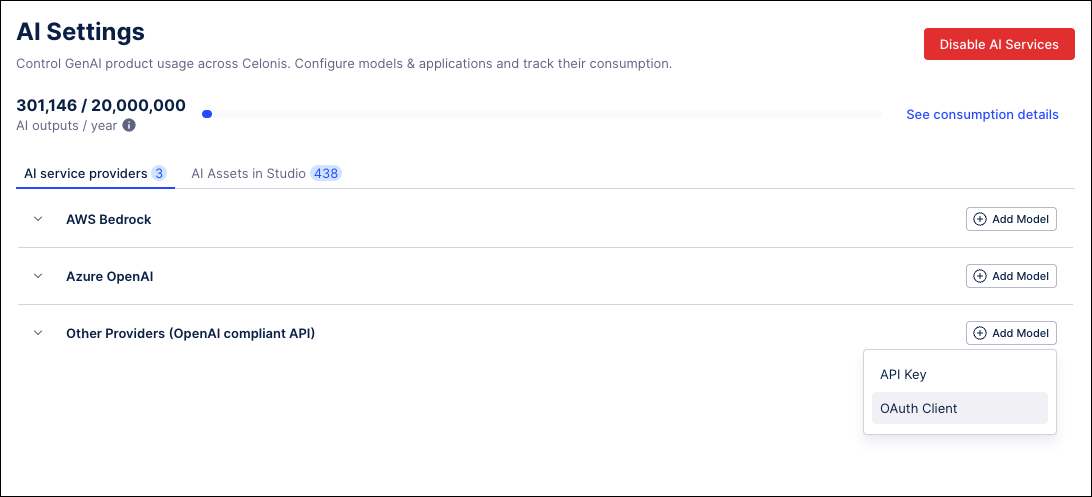 |
To use this new method, Admins can go to the “Other Providers (OpenAI compliant API)” section of the AI Settings screen, click the Add Model button and select “OAuth Client”. In the Add OpenAI compatible model OAuth window, your Admin can then create a configuration using OAuth specific fields such as the Token URL, Client ID, and Client Secret. Admins can also add optional Custom Headers as key-value pairs that are sent as part of the request.
For more information, see: AI Settings.
November 18, 2025
NEW PI GRAPH AI-powered Transformation Assistant in OCPM
The new AI-powered Transformation Assistant for OCPM is designed to use the available context of a specific object or event and create the corresponding SQL transformation code automatically. This assistant uses context such as the object name, attribute names, or the source system, as inputs and then utilizes AI to generate a custom data transformation script. The Transformation Assistant can generate all types of transformations except relationship transformations and can be used with both custom objects/events and for extensions of Celonis objects/events from the catalog.
Note
The AI Transformation Assistant only supports SAP ECC/S4 or Oracle EBS/Fusion source systems. Other source systems, including SAP add-ins such as VIM, APO, or EWM, or custom source systems, are not yet supported.
To use the Transformation Assistant, create a script in your transformation, and then click the Code Assistant button in the script editor. In the Code Assistant window, you can see what information will be used as context to write the script and then use the dropdowns to further customize your transformation script. Click Generate and the initial script will be created based on your selections.
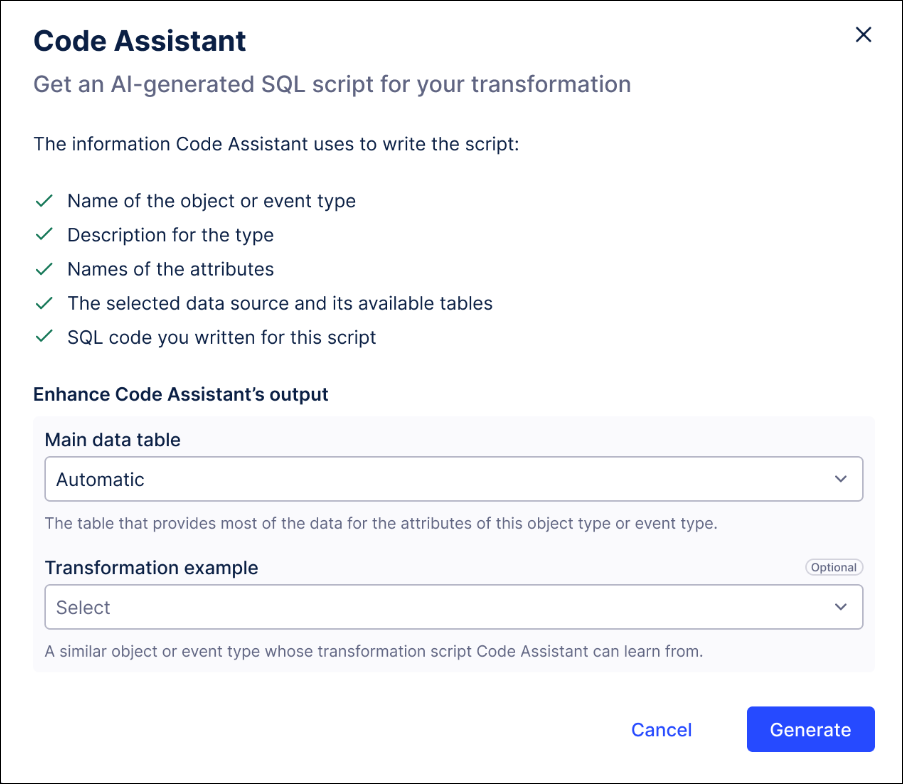 |
Once the initial transformation script has been generated, you can continue to refine the output by providing additional context and generating it again. When the script is regenerated, the assistant will show a side-by-side preview with the previous transformation to allow you to identify the changes.
This new assistant is only available in Celonis teams where the customer has already accepted the AI terms. Using the Transformation AI Assistant does not count against your team’s available AI outputs or impact your license in any way.
For more information, see: Creating custom transformations.
NEW PI GRAPH VARCHAR length optimization in transformations now in GA
When you publish transformations for object-centric process mining, we create complete transformations, using your scripts as the core of them, to populate the tables in the Celonis database of objects and events. Previously, we set the data type for any attribute column containing a string to VARCHAR(255). Now, we can set the string length for each attribute column according to what’s in the source data that the transformation is handling - either the specified length for the column, or the database default length for VARCHAR columns. If you set a VARCHAR length in your original transformation script, for example using the CAST or LTRIM functions, we'll continue to use that.
Optimizing the VARCHAR length means your transformations won’t fail due to overlength strings, and optimizes the performance of the Celonis database, which is very responsive to changes in string length. However, you should be aware that if the string columns in your source database are always or often set to a length greater than 255 characters, the performance of the Celonis database could potentially deteriorate rather than improve. You’ll see the changes becoming effective after publishing in objects and events to change the generated transformations.
November 17, 2025
IMPROVED ADMIN Team-to-team copy now supports copying Action Flows
After being released as a private preview, the team-to-team copy feature now fully supports the copying of Action Flows between teams.
As a team admin, you can bulk copy Studio packages and the latest version of your data pools between your teams. Using the Team-to-team copy feature, you select the team you want to copy your assets into (known as the target team), check and resolve asset dependencies, and run the copy.
For a video overview of this feature:
To learn more about copying assets between Celonis Platform teams and to see a full list of supported asset types, see: Team-to-team copy.
November 15, 2025
IMPROVED PROCESS DESIGNER Canvas app updates
We're continuing to add more functionalities to the Canvas app. This update includes:
Navigation for subprocesses or interfaces.
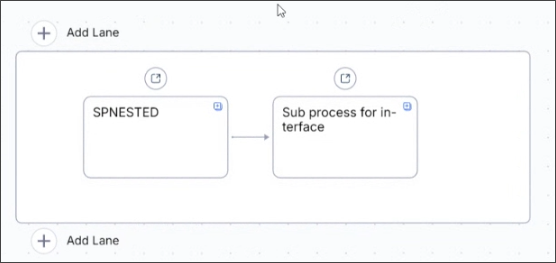
Multi-select, allowing for bulk edits or mass deletion.

Improved SVG export, allowing for clearer text.

For more information, see Enabling Canvas app.
November 14, 2025
IMPROVED STUDIO Configure input dropdown component with multiple variables
Following our successful private preview release, you can now update multiple variables from the same input dropdown in Studio Views. This feature allows your users to select between different customization of your View, where a single selection of your dropdown updates multiple variables with the values you specify.
For example, this app provides an input dropdown for users to switch between Consumer and Corporate views. And for each selection, the input dropdown saves their choice to three variables:
To learn more about configuring input dropdowns in Studio Views, see: Input dropdown.
November 13, 2025
IMPROVED STUDIO New quality insights about your Process Copilots
The Monitoring page for Process Copilots has been enhanced with several new features to help you better understand and improve the performance of your Process Copilots. Inside the monitoring section, we are adding KPI to provide you with a way to measure the value of the responses generated by each of your Process Copilots.
The new Aggregate Quality Overview panel at the top of the screen provides a high-level Quality Rate (%) for all conversations by this Process Copilot in the past 180 days and a summary of common failure types to help identify systemic issues.
To help prioritize improvements, the Conversations table now includes a Quality Score (%) column to rate the the quality of the responses in each conversation.
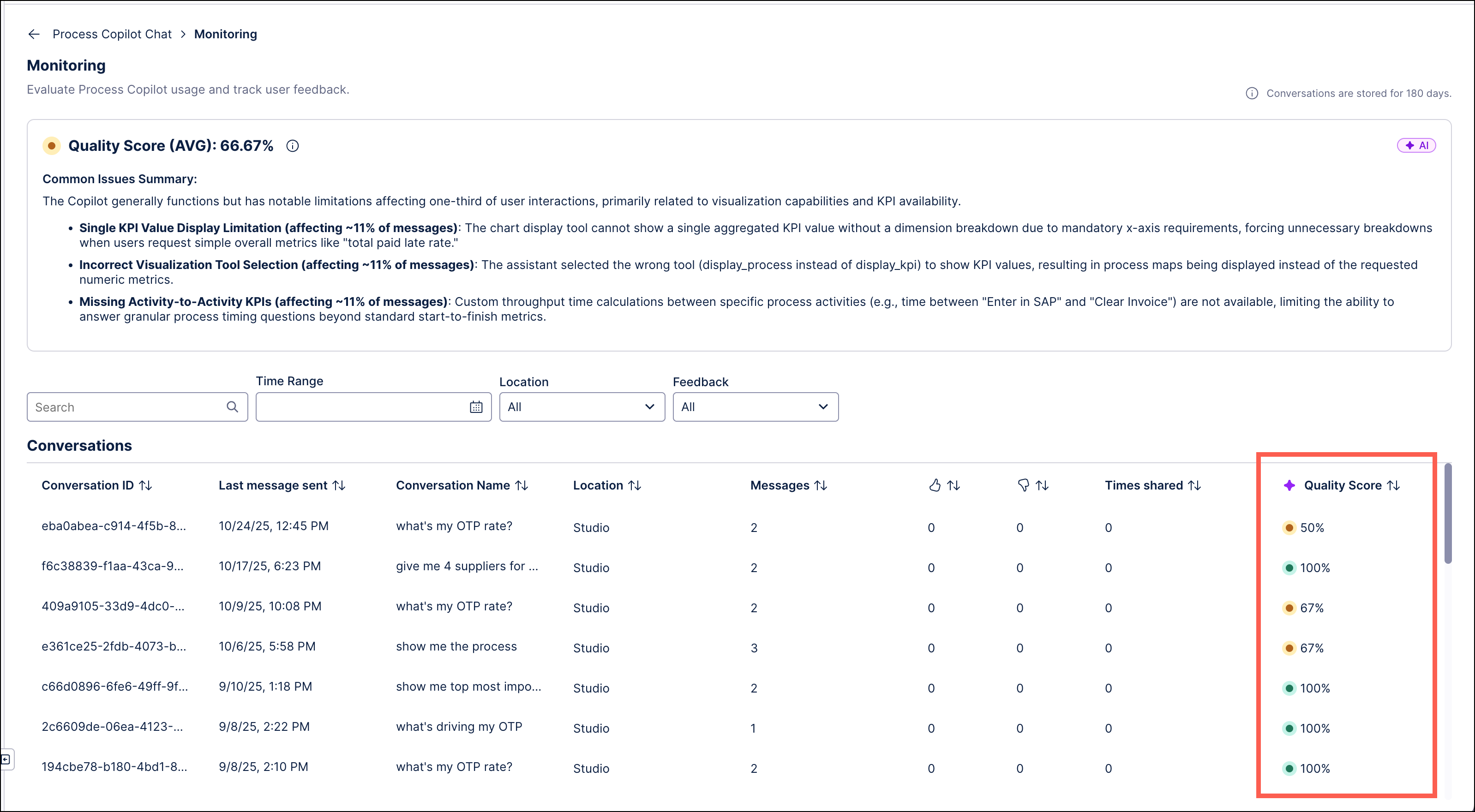
When viewing the transcript of a conversation, any low-scoring messages now include a Quality Score Driver with a clear, actionable explanation for the failure of this response, making it easier to identify the issue and resolve any root causes.
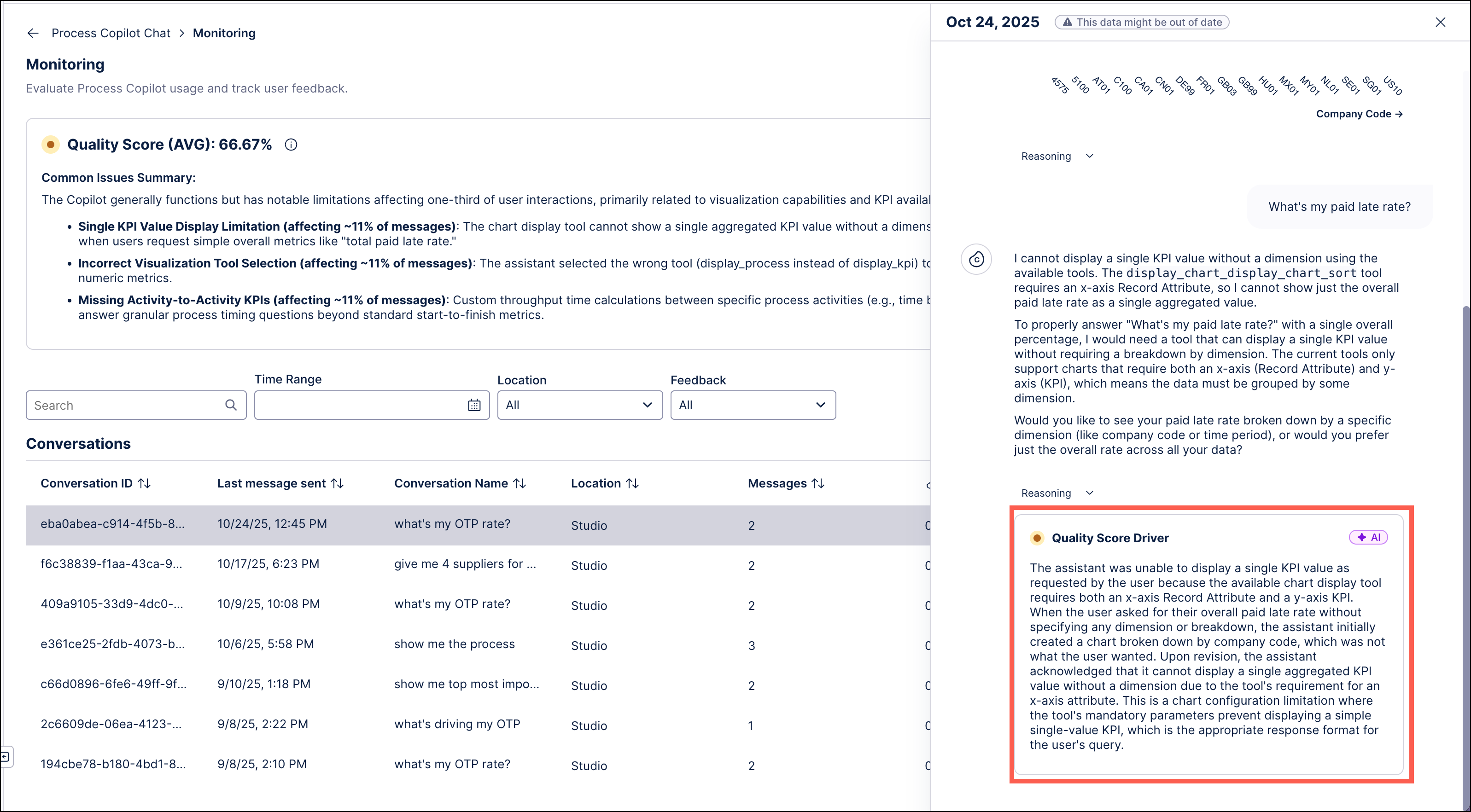
For more information, see Monitoring.
PRIVATE PREVIEW STUDIO Migrate legacy Views using the migration wizard
With this private preview release, you can now migrate your legacy Views using the new migration wizard. In addition to migrating individual View components, you can choose between a fast-track migration or a custom migration:
Default / Fast track migration: Automatically migrates your Legacy View and supported features using default settings.
Custom / Step-by-step migration: Lets you choose which connected views, components, and variables to migrate.
Legacy Views are views created using the pre–May 2024 Studio feature set (previously known as the general availability feature set). While you can still use Legacy Views in Studio, they are no longer being developed or enhanced. We recommend migrating your Legacy Views to the current Views feature to take advantage of the latest updates and improvements.
To learn how to migrate your legacy Views to Views, see: Migrating Legacy Views to Views.
And to learn more about our private and public preview releases, see: Feature release types.
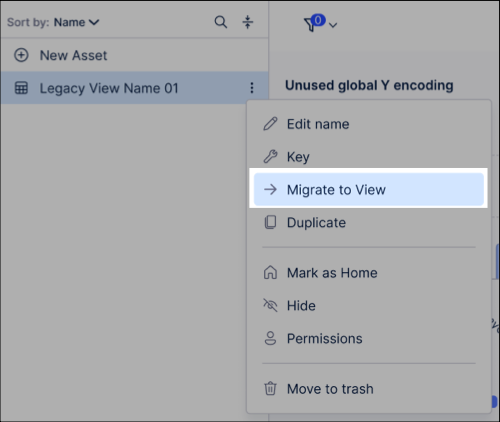
November 12, 2025
IMPROVED STUDIO Parameterized View Modules using variable mapping
You can now parameterize your Studio View Modules using View variables, allowing you to change the context of the data based on where the View module is embedded. This feature was previously available as a Private Preview only.
Instead of adding a single customer ID, date range, or business unit into the View, you can pass them as View Variables. This means that one View Module can be used across multiple Views and adjusted based on the context. View Variables allow you to apply filters or adjust logic at runtime, rather than duplicating the View and adjusting it as need. This keeps the Data Model lean and avoids redundant maintenance.
In this example, we've created a View variable for material types and then mapped this to a module variable:

To learn more about parameterizing your View Modules, see: View modules.
November 11, 2025
PRIVATE PREVIEW STUDIO Group package assets
With this limited private preview, you can now group Studio package assets by type, functionality, or custom criteria. You can also sort each group and create new asset types directly within it.
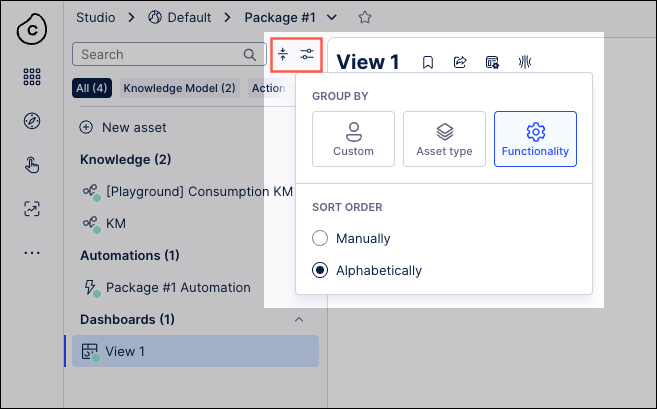
To learn more about managing your Studio package assets, head to Managing packages and permissions.
And to understand our Private Preview releases, see: Feature release types.
November 10, 2025
PUBLIC PREVIEW ADMIN Choose the theme for the Celonis Platform
This feature is currently available as a Public Preview only
During a Public Preview, only eligible customers can access this feature. Additionally, there may be minor updates to the functionality and design of these features when they are released in General Availability.
If you would like to use this feature, create a Support ticket at Celonis Support.
For more information about our Public Preview releases, including the level of Support offered with them, see: Feature release types.
Following the private preview release, the theme preset feature is now available as a public preview. The theme preset feature allows you to adjust the user interface colors and contrast to suit your needs.
The following theme presets can be selected from your profile management screen:
Light (default) – A classic, clean light-themed interface.
Dark – Optimized for low light and reduced eye strain.
High Contrast – Designed for maximum readability and accessibility.

Note: The following products do not support themes: Analysis, Action Flows, Advanced Views, Simulation Asset, Transformation Center, Business Miner, Forms, and Celonis Process Management (CPM).
For more information about choosing the theme for your Celonis Platform experience, head to Managing your user profile.
To learn more about public and private preview releases, see: Features currently in Private Preview and Public Preview.
IMPROVED DATA INTEGRATION Change to data retention policy when monitoring your pipeline
Our data pipeline monitoring is changing to a one-year maximum data retention policy. Any stored data older than 365 days will be automatically deleted at the end of each active monitoring day. This update is to ensure consistent and optimal performance of the monitoring app, improving your monitoring experience more efficient.
By enabling custom monitoring, you can collect monitoring data in a dedicated data pool. This dedicated monitoring data pool allows you to leverage Studio views to monitor your data pipelines.
For a video overview of how you can set up custom monitoring for your data pipeline:
And to learn more, see: Setting up custom monitoring.
IMPROVED DATA INTEGRATION Enabling email alerts for scheduled data jobs
You can now enable email alerts for both data jobs and scheduled data jobs, keeping you informed about the status of your data in the Celonis Platform.
Alerts can be configured for the following events:
Schedule fails: Whenever a data job schedule fails, send an email notification.
Schedule finishes successfully: When a data job schedule runs successfully, send an email notification for either the first time after a previous failure or in all cases.
Schedule gets skipped: When a data job schedule is skipped for either the first time or in all cases, send an email notification.
Schedule execution time: Send an email when a data job schedule execution time equals or exceeds the number of minutes entered.
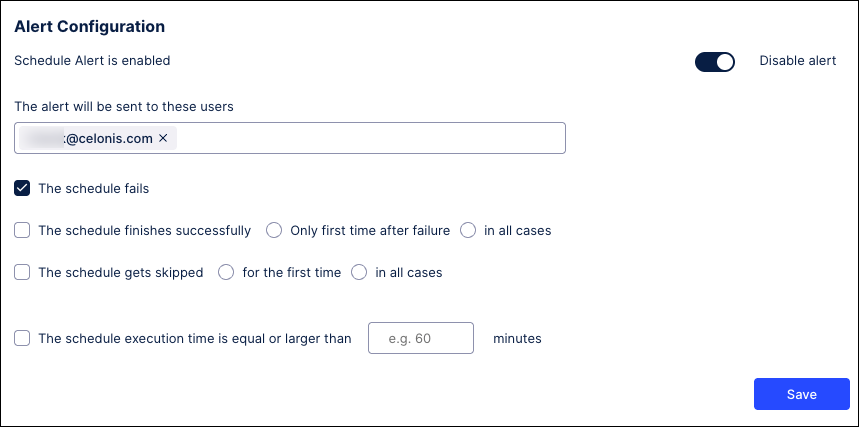
For more information about scheduling the execution of data jobs, see: Scheduling the execution of data jobs.
And to learn more about configuring data job alerts, see: Enabling data job and data job schedule alerts.
November 8, 2025
NEW SUPPORT New URL for the Celonis Support Center
From today, the Celonis Support Center is available at Support.Celonis.com, with a re-direct active for anyone using the previous Celopeers URL.
For more information about our Support Center, including contact times and language availability, see: Contacting Support
November 7, 2025
PRIVATE PI GRAPH New AI-powered data modeling assistant in OCDM
The Objects and Events module is introducing a new AI-powered data modeling assistant (DMA) in private preview. This DMA uses AI to recommend a set of objects and events, along with the associated attributes and relationships, based on your intended use case and the available data. Enter your request or use case in the chat, upload any attachments such as diagrams or process flows, and then click Submit.
 |
The DMA will use your inputs to provide an initial model that serves as the starting point for your OCDM model. You can then use the assistant’s chat functionality to adjust the recommended data model by adding, removing, or configuring the objects and events in the initial model.
You will still be able to view previous iterations of the model in the chat and return to those configurations if a change doesn’t have the expected result. Once you are satisfied with the configuration of your model, you can add the results directly into your environment by clicking the Build result button.
For more information, see Data modeling assistant. And for an overview of what our private and public preview releases entail, head to Feature release types.
PRIVATE PREVIEW DATA INTEGRATION AI assistant option added to Extractor Builder
With this private preview release, you use an AI assistant to generate configurations for custom REST API extractors from API specification files (OpenAPI, Swagger, or Postman Collection), speeding up connections to new source systems.
By uploading a JSON or YAML file, the AI assistant will identify the authentication methods and possible API endpoints, before then providing a confidence level in the connection. Then, once the extractor has been created, you can customize the connection as needed.
For a video demo of this feature:
To learn more about the Extractor Builder AI Assistant, see: Extractor Builder AI Assistant.
And for an overview of what our private and public preview releases entail, head to Feature release types.